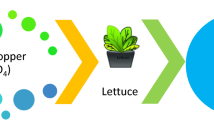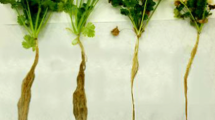Abstract
An attempt was made to explore the effect of copper sulphate treatment on growth, photosynthesis, osmolytes and antioxidants in 15 days old seedlings of C. cajan (Pigeonpea). C. cajan seedlings were grown in 0, 1, 5 and 10 mM concentrations of copper sulphate in petriplates lined with Whatman filter paper for 15 days. Root length and shoot length was decreased in a dose dependent manner with highest decrease of 82.80 and 45.92% in 10 mM Cu stress. Photosynthetic efficiency (qP, qN and Y) was decreased in a dose dependent manner whereas NPQ was increased in 1 and 5 mM and decreased in 10 mM Cu. Photosynthetic pigments viz total chlorophyll and carotenoids were increased in low concentrations and decreased in high concentrations of Cu. Osmolytes such as proline, glycine betaine and sugars were found to be increased in a dose dependent manner. Similarly antioxidants such as superoxide dismutase and catalase increased to 129.17 and 169.7%, respectively under Cu stress. Vitamin C and vitamin E was also increased in different concentrations of Cu to a significant level. It can be concluded from the present study that C. cajan can tolerate Cu stress up to 5 mM by adjusting the proportion of proline, glycine betaine, sugars and vitamins along with increasing the activity of some of the antioxidant enzymes.

Similar content being viewed by others

References
Aebi H (1983) Catalase. In: Bergmeyer HU (ed) Methods of enzymatic analysis. Verlag-Chemie, Weinham, pp 673–684
Ali S, Shahbaz M, Shahzad AN, Khan HAA, Anees M, Haider, Fatima A (2015) Impact of copper toxicity on stone-head cabbage (Brassica oleracea var. capitata) in hydroponics. Peer J 3:e1119
Ashagre H, Almaw D, Feyisa T (2013) Effect of copper and zinc on seed germination, phytotoxicity, tolerance and seedling vigor of tomato (Lycopersicon esculentum L. cultivar Roma VF). Int J Agric Sci Res 2:312–317
Azooz MM, Abou-Elhamd MF, Al-Fredan MA (2012) Biphasic effect of copper on growth, proline, lipid peroxidation and antioxidant enzyme activities of wheat (Triticum aestivum cv. Hasaawi) at early growing stage. Aust J Crop Sci 6:688–694
Bates LS, Waldren RP, Teare ID (1973) Rapid determination of free proline for water stress studies. Plant Soil 39:205–208
Brahim L, Mohamed M (2011) Effects of copper stress on antioxidative enzymes, chlorophyll and protein content in Atriplex halimus. Afr J Biotechnol 10:10143–10148
Chai M, Shi F, Li R, Qiu G, Liu F, Liu L (2014) Growth and physiological responses to copper stress in a halophyte Spartina alterniflora (Poaceae). Acta Physiol Plant 36:745–754
Chinoy JJ, Singh YD, Gurumurthi K (1976) The role of ascorbic acid in growth, differentiation and metabolism of plants. J Plant Physiol 22:122
Dey S, Mazumder PB, Paul SB (2014) Effect of copper on growth and chlorophyll content in tea plants (Camellia sinensis (L.) O. Kuntze). Int J Res Appl Natl Soc Sci 2:223–230
Dubois M, Gilles KA, Hamilton JK, Rebers PA, Smith F (1956) Colorimetric method for determination of sugars and related substances. Anal Chem 28(3):350–356
Ezike AC, Akah PA, Okoli CC, Okpala CB (2010) Experimental evidence for the antidiabetic activity of Cajanus cajan leaves in rats. J Basic Clin Pharmacol 1:25–30
Fidalgo F, Azenha M, Silva AF, Sousa A, Santiago A, Ferraz P, Teixeira J (2013) Copper-induced stress in Solanum nigrum L. and antioxidant defense system responses. Food Energy Secur 2:70–80
González-Mendoza D, Gil FEY, Escoboza-Garcia F, Santamaría JM, Zapata-Perez, OM (2013) Copper stress on photosynthesis of black mangle (Avicennia germinans). Acad Bras Cienc 85:665–670
Greive CM, Grattan SR (1983) Rapid assay for determination of water-soluble quaternary amino compounds. Plant Soil 70:303–307
Grossman K, Zakut R (1979) Determination of the activity of lipoxygenase. Methods Biochem Anal 25:303–329
Hattab S, Hattab S, Banni M, Hernández LE, Boussetta H (2013) Modulation of antioxidant responses of Medicago sativa under cadmium and copper stress. Afr J Agric Res 8:2297–2306
Heath RL, Packer L (1968) Photoperoxidation in isolated chloroplast: 1. Kinetics and stoichiometry of fatty acid peroxidation. Arch Biochem Biophy 125:189–198
Jiang W, Liu D, Liu X (2001) Effects of copper on root growth, cell division, and nucleolus of Zea mays. Biol Plant 44:105–109
Juan JH, Lu Z, Qing LH, Jia SK, Hao W, Sheng WY, Yuan HG, Rong TX (2012) Exogenous phytic acid inhibits early growth of wheat seedlings (Triticum aestivum L.) by decreasing superoxide anion derived from NADPH oxidase. Aust J Crop Sci 8:1221–1227
Kalai T, Khamassi K, da Silva JAT (2014) Cadmium and copper stress affect seedling growth and enzymatic activities in germinating barley seeds. Arch Agron Soil Sci 60:6
Kono Y (1978) Generation of superoxide radical during autooxidation of hydroxylamine and an assay for superoxide dismutase. Arch Biochem Biophys 186:189–195
Lichtenthaler HK (1987) Chlorophylls and carotenoids: pigments of photosynthetic biomembranes. In: Packer L, Douce R (eds) Methods in enzymology, vol 148. Academic Press, New York, pp 350–382
Loewus FA (1952) Improvement in the anthrone method for determination of carbohydrates. Ann Chem 2:219
Manivasagaperumal R, Balamurugan S, Thiyagarajan G, Sekar J (2011) Effect of zinc on germination, seedling growth and biochemical content of cluster bean (Cyamopsis tetragonoloba (L.) Taub). Curr Bot 2:11–15
Marschner H (1995) Mineral nutrition of higher plants, 2nd edn. Academic Press, London, p 889
Meng QM, Zou J, Zou JH, Jiang WS, Liu DH (2007) Effect of Cu2+ concentration on growth, antioxidant enzyme activity and malondialdehyde content in Garlic (Allium sativum L.). Acta Biol Crac Bot 49:95–101
Miliauskas G, Venskutonis PR, Van Beek TA (2004) Screening of radical scavenging activity of some medicinal and aromatic plant extracts. Food Chem 85:231–237
Nelson N (1944) A photometric adaptation of Somogyi method for the determination of glucose. J Biol Chem 153:315–380
Nomura T, Itouga M, Kojima M, Kato Y, Sakakibara H, Hasezawa S (2015) Copper mediates auxin signalling to control cell differentiation in the copper moss Scopelophila cataractae. J Exp Bot 66:1205–1213
Osuagwu CG (2010) Mechanism of the antisickling effects of Cajanus cajan and phenylalanine. Niger J Biochem Mol Biol 25:68–71
Oyewole O, Owoseni AA, Faboro EO (2010) Studies on medicinal and toxicological properties of Cajanus cajan, Ricinus communis and Thymus vulgaris leaf extracts. J Med Plant Res 4:2004–2008
Peng H, Kroneck PM, Küpper H (2013) Toxicity and deficiency of copper in Elsholtzia splendens affect photosynthesis biophysics, pigments and metal accumulation. Environ Sci Technol 47:6120–6128
Poonam S, Kaur H, Geetika S (2013) Effect of jasmonic acid on photosynthetic pigments and stress markers in Cajanus cajan (L.) Millsp. seedlings under copper stress. Am J Plant Sci 04:817–823
Putter J (1974) Peroxidase. In: Bergmeyer HU (ed) Methods of enzymatic analysis. Verlag Chemie, Weinham, pp 685–690
Raven JA, Evans MCW, Korb RE (1999) The role of trace metals in photosynthetic electron transport in 02- evolving organisms. Photosynth Res 60:111–150
Ritter A, Goulitquer S, Salaün JP, Tonon T, Correa JA, Potin P (2008) Copper stress induces biosynthesis of octadecanoid and eicosanoid oxygenated derivatives in the brown algal kelp Laminaria digitata. New Phytol 180:809–821
Rodríguez-Calcerrada J, Shahin O, Carmen del Rey C, Rambal S (2011) Opposite changes in leaf dark respiration and soluble sugars with drought in two Mediterranean oaks. Funct Plant Biol 38:1004–1015
Rosenberg HR (1992) Chemistry and physiology of vitamins. Inter Science Publishers Inc., New York, pp 452–453
Sharma RK, Agarwal M (2005) Biological effects of heavy metals: an overview. J Environ Biol 26:301–313
Singh A, Lawrencea K, Pandita S, Lawrenceb RS (2007) Response of leaves, stems and roots of Withania somnifera to copper stress. Int J Plant Anim Environ Sci 4:1–60
Singh S, Mehta A, Mehta P (2011) Hepatoprotective activity of Cajanus cajan against carbon tetrachloride induced liver damage. Int J Pharm Pharm Sci 3:3–4
Thounaojam TC, Panda P, Mazumdar P, Kumar D, Sharma GD, Sahoo L, Panda SK (2012) Excess copper induced oxidative stress and response of antioxidants in rice. Plant Physiol Biotech 53:33–39
Tie SG, Tang ZJ, Zhao YM, Li W (2012) Oxidative damage and antioxidant response caused by excess copper in leaves of maize. Afr J Biotech 11:4378–4384
Wang XH, Song YP, Ren J, Liu TK, Hou XL, Li Y (2013) Response of biomass and photosynthesis in non-heading chinese cabbage to excess copper. J Anim Plant Sci 23:1659–1665
Winkler UK, Stuckmann M (1979) Glycogen hyaluronate and some other polysaccharide greatly entrance the formation of exolipase by Serratia marcescens. J Bacteriol 138:663–670
Wu Y, Zhang D, Chu JY, Boyle P, Wang Y, Brindle ID (2012) The Arabidopsis NPR1 protein is a receptor for the plant defense hormone salicylic acid. Cell Rep 1:639–647
Yan S, Dong X (2014) Perception of the plant immune signal salicylic acid. Curr Opin Plant Biol 20:64–68
Yruela I (2005) Copper in plants. Braz J Plant Physiol 17:145–156
Zengin FK, Kirbag S (2007) Effects of Cu on chlorophyll, proline, protein and abscisic acid acid level of sunflower (Helianthus annuus L.) seedlings. J Environ Biol 28:561–566
Zhao S, Liu Q, Qi Y, Duo L (2010) Responses of root growth and protective enzymes to copper stress in turfgrass. Acta Biol Crac Bot 52:7–11
Acknowledgment
Authors are highly acknowledged to Department of Science and Technology, New Delhi (DST, New Delhi) for financial support in the form of Women Scientist Project (WOS-A); Head, Department of Botany, Punjabi University Patiala for providing experimental facility and Head, Plant Breeding and Genetics, Punjab Agriculture University, Ludhiana for providing certified seeds of pigeonpea.
Author information
Authors and Affiliations
Corresponding author
Rights and permissions
About this article
Cite this article
Sharma, P., Sirhindi, G., Singh, A.K. et al. Consequences of copper treatment on pigeon pea photosynthesis, osmolytes and antioxidants defense. Physiol Mol Biol Plants 23, 809–816 (2017). https://doi.org/10.1007/s12298-017-0461-8
Received:
Accepted:
Published:
Issue Date:
DOI: https://doi.org/10.1007/s12298-017-0461-8



